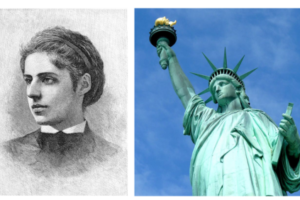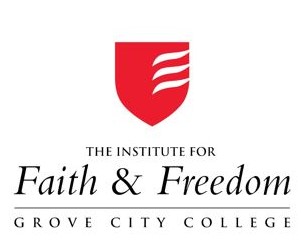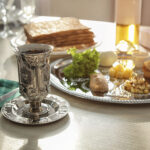The Preposterous Politics of Passover: The Use and Misuse of the Haggadah in Our Time

The Biblical 8-day festival of Passover concludes next Tuesday evening. This piece about the best-known and perhaps best-loved Jewish holiday dates from April 2011 and first appeared in Commentary Magazine. Many of its observations, for better or worse, still apply.
…
For all those who have nourished an intense if unspoken yearning to experience a Passover seder with veteran news stars Steve and Cokie Roberts, your long wait is finally over: March 2011 has brought us Our Haggadah: Uniting Traditions for Interfaith Families. Promotional materials from HarperCollins promise “a unique, personalized vision of the traditional Passover Haggadah, combining their own family traditions with favorites from other families in a fun, intimate guide” that will leave readers “enthralled by this glimpse into the couple’s inclusive Passover rituals.”
Mary Martha Corinne Morrison Claiborne Boggs “Cokie” Roberts remains a proud Roman Catholic and so, despite her enviable career as a broadcast journalist for ABC and NPR, she might not constitute the most obvious choice to reformulate the ancient liturgy of the festival most firmly associated with the emergence of the Jewish people as a distinctive nation with a unique godly calling. Her husband, Steven V. Roberts, has written about growing up in an Eastern European Jewish family in New Jersey (My Fathers’ Houses, 2005) and then making his way to Harvard, the New York Times, U.S. News & World Report, and the faculty of George Washington University, but he has never emphasized religious scholarship or commitment in his work. To lend an air of traditionalism and authenticity to their new venture, Cokie and Steve launched their Our Haggadah book tour at the Lower East Side Tenement Museum on Orchard Street, apparently ignoring the likelihood that the impoverished, fiercely Jewish immigrant masses who made that gritty neighborhood their portal to America would have lacked both the inclination and the funds to shell out 20 bucks to purchase a “fun, intimate” interfaith Haggadah.
Our Haggadah has the highest profile of more than a dozen new Haggadot (the proper plural version of Haggadah) unleashed on a mostly unsuspecting public just in time for this year’s holiday observance. In a superficial way, these versions of the medieval rabbinical assemblage of prayers, stories, fables, songs, and eating rituals are a testament to the extraordinary variety of cultures and worldviews within today’s American Jewish community: a simple search for the word “Haggadah” on Amazon.com yields an impressive 1,173 results, most of them linking to publications of the past 30 years. But they also reveal the contours of a culture war. Passover is the most important holiday relating to the Jewish people as a people, and the Haggadah is the best-known Jewish text outside the prayer book and the Torah. It makes perfect sense, therefore, that it has become a political battleground, and not only within the notoriously fractious confines of American Jewry.
Indeed, several of these new approaches to the yearly Pesach feast cater to the growing trend among evangelical Christians to celebrate their own Christ-centered seders as a means of connecting with their faith’s Hebrew roots. The Lamb and His Shadow: A Christian Passover Guide features the traditional Jewish blessings and formulations, respectfully, even lovingly, presented in Hebrew, with transliteration and English translation, but packaged behind a profoundly unappetizing cover photograph of matzo-ball soup in a Star-of-David-shaped bowl, featuring twigs of rosemary and a large chunk of unskinned salmon. The commentary, by the Texas husband-and-wife team S. Blair and Tracy Korschun, ingeniously finds christological references in every Passover tradition. For instance, during the traditional washing of the hands before tasting the first bite of karpas (fresh greens), they suggest that participants should “think of the scene from the last supper where Christ washed the apostles’ feet prior to the Passover Last Supper.” Concerning the unleavened bread and the three matzo loaves of the seder plate (which are said to represent the Trinity), they note: “Christ becomes a new lump or new leaven for us which will never die or pass away. So we are being commanded to not eat of temporary leaven but rather to hold out for the eternal leaven found in the body of Christ.”
While Christians correctly insist that Jesus of Nazareth participated in Passover seders throughout his brief life, there’s no evidence whatsoever that Siddhartha Gautama, the sixth century b.c.e. Indian prince who founded Buddhism, ever sampled bitter herbs, matzo, or Pesach wine. Nonetheless, the promoters of The Haggadah for Jews and Buddhists (2006) insist that “Jewish tradition flows naturally through the landscape of Buddhist belief, enhancing, not detracting.” Its cover features a traditional statue of the Buddha, meditating in the lotus position, while a neon-illuminated Star of David glows above his head, as if to illustrate the true nature of his enlightened thoughts. Edited by Elizabeth Pearce-Glassheim, who was “raised by Catholic parents who had a lifelong fascination with Buddhism” before marrying into a Jewish family, the book carefully ensures that “the more violent elements of the Passover story are balanced by the emphasis on peace of Buddhism,” adding “an extra bit of peace, stillness and, yes, even meditation to the Passover ritual.” Considering the raucous, boisterous nature of most seders of my experience, the idea of “stillness” and “meditation” as part of the annual family gathering sounds profoundly exotic, as do the prescribed recitation of Buddha’s Four Noble Truths (a response to Pearce-Glassheim’s reformulated Four Questions) and the chanting of “Eight Verses for Training the Mind” by Genshe Langri Thangpa.
The editor of the nirvana-seeking JewBu Haggadah acknowledges that she found her inspiration from a previous influential innovator, Karen G.R. Roekard, who completed her own 18-year “grand tour of spiritual traditions” in 1992 with the publication of The Santa Cruz Haggadah: A Passover Haggadah, Coloring Book, and Journal for Evolving Consciousness. This mellow meld of New Age insights and Bible stories for children urged participants to “connect with other groups who are needing freedom or protection now—the homeless, the redwoods, those discriminated against because of their age, sex, sexual preferences, etc.” The “evolving consciousness” invoked in the subtitle focuses attention on “the ways in which we enslave ourselves now through the risks we don’t take . . . the questions we don’t ask” and promised “a violence-free and God-neutral teaching tool for parents and/or teachers.”
Other noteworthy Haggadot have provided a radically different perspective—not violence-free and God-neutral but instead extolling violence against perceived American oppression and calling on a vengeful God to punish capitalist exploiters. Most famously, Rabbi Arthur Waskow created the “Freedom Seder” in 1969, with its own Haggadah, complete with crudely drawn agitprop illustrations, published initially in Ramparts magazine and then later by Holt Rinehart Winston.
Waskow has said that the assassination of Dr. Martin Luther King just 10 days before Passover in 1968 provided his initial inspiration. “His death called forth a Black uprising in many American cities, followed by the US Army’s armed occupation of my neighborhood in Washington DC,” he wrote in 2005. “Walking past the troops as I prepared for Passover, I was overwhelmed to find myself feeling and thinking, ‘This is Pharaoh’s Army!’ ”
Waskow couldn’t call forth supernatural plagues or Red Sea waters to wipe out the American military, but he did invoke the bloody words of various figures in “liberation” history in his new Haggadah, pointedly comparing them to biblical shoftim (judges):
It was not bloodless when the shofet Nat Turner proclaimed, “I had a vision, and I saw white spirits and black spirits engaged in battle, and the sun was darkened, the thunder rolled in the heavens and blood flowed in streams . . . ”
And it was not bloodless when shofet Eldridge Cleaver (who went into exile like Moses) said . . . “It was too late because it was time for the blacks (‘I’ve got a mind of my own!’) to riot, to seep through the Harlem night like a wave of locusts, breaking, screaming, bleeding, laughing, crying, rejoicing, celebrating, in a jubilee of destruction, to regurgitate the white man’s bullshit they’d been eating for four hundred years; smashing the windows of the white man’s stores, throwing bricks they wished were bombs, running, leaping, whirling like a cyclone through the white man’s Mind, past his backlash, through the night streets of Rochester, New Jersey, Philadelphia.”
Naturally, Waskow never acknowledged that the “white man’s stores” whose destruction he celebrated may have been in some cases the struggling enterprises operated by parents of the radical participants in his Freedom Seders, one of which drew 800 people in 1969 and was broadcast live on New York City’s WBAI radio and throughout Canada on CBC. The next year, the Freedom Seder Show packed 4,000 into the field house at Cornell University and featured a special guest appearance by antiwar activist Father Daniel Berrigan, at the time a high-priority fugitive from the FBI (more minions of Pharaoh’s Army, no doubt).
In his original liturgy of 40 years ago, Rabbi Waskow composed a fresh, contemporary version of the beloved traditional song “Dayenu” (“It would have been enough”), reading in part:
If we were to end outright police brutality but not prevent some people from wallowing in luxury while others starved, it would not be sufficient;
If we were to make sure that no one starved but were not to free the daring poets from their jails, it would not be sufficient;
If we were to free the poets from their jails but to train the minds of people so that they could not understand the poems, it would not be sufficient.
Waskow tried again with fresh creations for his “New Freedom Seder” of 2004, aimed directly at unshackling suffering humanity from the galling chains of the George W. Bush administration. As he put it in his introduction: “New Pharaohs have arisen. It is time for a new birth of freedom, time for a NEW FREEDOM SEDER.”
This time, the recitation of the Ten Plagues included a guide to contemporary afflictions:
• Water into Blood (Pollution & privatization of water; the flood that destroyed New Orleans)
• Frogs (Frogs—dead & maimed by chemicals)
• Vermin (Poverty)
• Beasts (Extinction of thousands of species)
• Boils/Pestilence (Collapse of health system; disappearance of health insurance . . . neglect of people with HIV and AIDS)
• Hail (Radical climate change, global scorching)
• Locusts (Famine, genetically modified foods patented seeds)
And who bore responsibility for these horrors? The New Freedom Seder reveals all with yet another poem/chant “Big Oil Burning: The Planetary Pharaohs,” which explains:
They melt the ice caps that keep our planet balanced
They torch great Amazon forests.
Their Saudi branch pipe-line paid to explode the Twin Tower
And their Texas branch pipe-line cooked lies to burn Iraqi cities.
With oily money they bought the oil-soaked White House
They scorch all earth, befoul all oceans.
In other words, the New Freedom Seder imputes to Big Oil the same awe-inspiring omnipotence that a traditional Haggadah imputes to God.
At the same time, Waskow reveled in his own power to inspire seemingly countless followers and imitators to be Haggadah entrepreneurs. “Beyond the specific content of the original Freedom Seder,” he wrote in 2004, “during the years since 1969 it has seeded a great harvest of new versions of the Seder that have spoken to many forms of freedom: feminism, peace between Israelis and Palestinians, ending the danger of nuclear holocaust, achieving eco-sanity, solidarity with Latin American movements against tyrannical rulers, personal spiritual liberation.”
In fact, the popular Haggadot of recent years most often focus on one special cause or another (climate change, gay liberation, immigration rights, animal rights) rather than express the generalized, free-floating rage that characterized Waskow World. For instance, Like an Orange on a Seder Plate: Our Lesbian Haggadah (1999) promised to recast “all the rituals and symbols of Passover” in a style that is “lesbian centered and woman affirming.” The odd title concerns a profound interchange that may have altered the course of modern Jewish history, according to its author, Ruth Simkin. “Not so very long ago,” she writes, “a woman wanted to know why women can’t be up on the bimah (altar) holding the Torah. She asked the rabbi why this was so. The ‘learned rabbi’ responded, stroking his beard: ‘A woman should be on a bimah like an orange should be on the Seder plate!’ Now, each year at Passover, we give to an orange the place of honor on our Seder plate.”
This tidy explanation for the increasingly popular new “tradition” of including an orange with the centerpiece for the Passover meal may sound witty and rebellious, but it’s also entirely untrue. In a 2002 lecture, the feminist Susannah Heschel (daughter of the world-renowned sage Abraham Joshua Heschel) revealed that “what you hear is not what actually happened. It’s been circulating for a long time and it’s become a bit of an urban legend.”
Heschel insists that she personally initiated the orange-on-the-seder-plate ritual during a visit to Oberlin College in the early 1980s. The students had written their own creative Haggadah to express sympathy with various oppressed groups. This novel liturgy included the shocking placement of a crust of leavened bread at the center of the table—in pointed defiance of strict prohibitions against any form of leavened foodstuffs anywhere in Jewish homes during the eight-day Passover festival. The students felt that their daring importation of yeasty baked goods expressed support for beleaguered homosexuals: since the tradition strongly disapproves of same-sex romance, they would make it a focus of their Haggadah to challenge another ancient prohibition. As Heschel, professor of Jewish Studies at Dartmouth, pointedly recalled, they sought “a sign of solidarity with Jewish lesbians and gay men, since ‘there’s as much room for a lesbian in Judaism as there is for a crust of bread on the seder plate.’ ”
While approving of their sentiments, she disagreed with their radical gesture, with “symbolism suggesting that being lesbian is being transgressive, violating Judaism. I felt that an orange was suggestive of something else: the fruitfulness for all Jews when lesbians and gay men are contributing and active members of Jewish life.” According to Heschel: “That first year I used a tangerine. Everyone at the seder got a section of it and as we ate it we could spit out the seeds in solidarity with homosexuals—the seeds represented homophobia.”
While the gesture of public spitting never caught on as a celebration of gay pride, oranges still turn up at many politically minded seders and would certainly find acceptance within the limited menu specified by the popular Haggadah for the Liberated Lamb (1988), which focuses on vegetarianism and animal rights. Rather than emphasizing the suffering of long-ago slaves in Egypt, Roberta Kalechofsky (author of the illustrated fable A Boy, a Chicken, and the Lion of Judah: How Ari Became a Vegetarian) stresses the unspeakable cruelty visited upon cows, poultry, sheep, and other beasts bred for slaughter. In a sense, her approach recalls the distasteful comparison of human and beastly anguish epitomized in PETA’s notorious anti-meat campaign labeled “A Holocaust on Your Plate.” A friend recently attended a “Liberated Lamb” seder with his young children, but the kids eventually left the table in tears over the gruesome descriptions of factory farming and brutal stockyards.
This points up one of the problems with recent efforts to bring the ancient Haggadah up to date: the grim tone that often creeps into these volumes and brings a distinctly sour note to a holiday generally perceived as joyous and (with the help of four required cups of wine) almost euphoric. For instance, The Liberated Haggadah: A Passover Celebration for Cultural, Secular, and Humanistic Jews (2006) promptly dismisses the Exodus story as mythical rather than historical, excludes any references to a divine role in the liberation from bondage, and treats the entire tale as “a humanist parable, highlighting contemporary relevance.” In that regard, this Haggadah offers a modern “Four Questions”: in place of the time-honored queries about eating matzo and bitter herbs, or dining while reclining, it poses deeper challenges, such as “Why can we get people to the moon but we cannot get the homeless adequate shelters?” and “As believers in freedom, should we not support Palestinian rights to self-determination?” Discussion points also include oppression of immigrants, modern-day sex slavery, militarism, drug addiction, AIDS, forced labor, environmental catastrophe, and economic exploitation. As in so many contemporary Haggadot, the somber tone of this unabashedly secular text gives the lie to the notion that religious believers display a gloomier outlook, or a greater fixation on fire and brimstone, than their issues-obsessed freethinking counterparts.
The impulse to revise and update the prescribed service for the family Passover meal remains apparently unquenchable despite the distinctly limited distribution of nearly all the freshly minted versions of cherished liturgy. In fact, only one Haggadah in history counts as an unquestioned bestseller, and it presents the unadorned, time-honored Orthodox text with a careful, pedestrian English translation and no frills or extras of any kind.
The Maxwell House Haggadah first appeared in 1934 as a promotional gimmick for the coffee company, offered free with the purchase of a can of certified kosher-for-Passover coffee and bearing the assurance that “this Haggadah is complete. There are no deletions from the traditional version, in either Hebrew or English.” Joseph Jacobs, formerly advertising manager for the Yiddish-language Jewish Daily Forward in the 1920s, came up with the concept of distributing the utilitarian booklets in association with a rabbinic breakthrough of the era. In 1923, the respected Rabbi Bezalel Rosen determined definitively that the coffee bean counted as a berry, not a bean or legume—an important distinction for Ashkenazic Jews who are prohibited from consuming legumes on Passover. To emphasize the new freedom to enjoy a steaming cup of Joe during the eight-day holiday, Jacobs devised a campaign likening a goblet of Maxwell House to “the fifth cup at the seder.”
Over 75 years of distribution, more than 50 million copies of the Maxwell House Haggadah have been distributed—an amazing figure considering that the American Jewish population at its peak barely reached six million. In 2006 alone, more than one million homes worldwide used the Maxwell House Haggadah, making it by far the most widely used Haggadah in history. In 2009, photographs of the White House seder conducted by Barack Obama for his Jewish staff and friends showed the president of the United States and his guests employing this plain, practical, stubbornly old-fashioned alternative to the edgier, more challenging editions favored by many of his fashionable supporters.
The case for continued innovation with novel, issues-oriented Haggadot centers on the perception of Judaism as a flexible, constantly evolving religious tradition, with new symbols (oranges or bread crusts at the seder, anyone?), ritual practices, and prayers developing in every generation. Scholars agree that the traditional Haggadah text took shape at least a thousand years after Moses, and perhaps as late as the ninth century of the Common Era, though some argue it was largely formulated by Rabbi Yehuda HaNasi (Judah the Prince), the same towering figure who redacted the Mishna in the second century.
In any event, the Haggadah’s content and order (seder means “order”) have remained virtually unchanged for at least 1,000 years, from the Middle Ages to Maxwell House. The famous illuminated manuscripts displayed in Jewish museums (like the celebrated ca. 1300 “Birds’ Head Haggadah” from southern Germany, which depicts human beings with stylized avian faces) command attention with their vivid, often imaginative illustrations, but the artfully inscribed text remains identical from place to place and century to century. My mother’s father, who served in the kaiser’s army in World War I, made use of the Kriegs-Hagadah distributed to all Jewish troops in 1914-16. The cover looks bizarre from the perspective of subsequent history, with its prominent photograph of Wilhelm II in full military regalia facing a similar image of his ally Emperor Franz Josef of Austria-Hungary, but the contents feature the same Hebrew passages we use to this day.
Even the early efforts of the American Reform movement to make the Haggadah more relevant and modern took only limited liberties with its core elements. The Union Haggadah of 1908 provided more graceful translations but made notably timid efforts to supplement the familiar essentials. For instance, the Central Conference of American Rabbis did authorize the inclusion of several recently composed hymns, including “God of Might, God of Right” by the highly esteemed Rabbi Gustav Gottheil, longtime spiritual leader of New York’s Temple Emmanu-El. To the tune of “Adir Hu” (composed sometime in the early 1600s and sung toward the seder’s conclusion), he suggested the words: “God of might, God of right / Thee we give all glory; / Thine all praise in these days / As in ages hoary.”
Within a generation, Gottheil’s words themselves seemed to belong to “ages hoary” and fell quickly out of fashion, highlighting a major risk for all authors of new Haggadah material: for the last thousand years, at least, the shelf life of such fresh contributions has been sharply limited. For instance, the Freedom Seder’s admiring inclusion of Eldridge Cleaver’s glorification of inner-city riots didn’t play well after the Black Panther’s return from his (Moses-like?) exile in Algeria and Cuba, especially after he endorsed Ronald Reagan for president in 1980.
Ironically, the Jewish festival that most explicitly emphasizes freedom and liberation simultaneously highlights the inescapable bonds of tradition—especially with a surprising 77 percent of American Jews reporting that they observe the holiday of Passover, according to the National Jewish Population Survey of 2003, more than any other form of religious participation.
The sages find no contradiction in this apparent anomaly of a “festival of liberation” that seems to drive people to repeat the patterns of the past. In their view, the Exodus didn’t so much grant us freedom from slavery as it provided the freedom to serve God and to follow his law. When Moses approached Pharaoh, he didn’t plead, “Let my people go” (except in the beloved spiritual, associated with black slaves); the biblical text shows Moses and Aaron repeatedly demanding that the Egyptian ruler should follow the divine command to “send my people out to serve me in the wilderness.”
The escape from Egypt remains firmly connected to the revelation of the Torah on Mount Sinai, with all its rules and regulations for national life. The “Counting of the Omer,” the formal 50-day countdown to that great event and the Shavuot holiday that commemorates it, begins at the second Passover seder. The frantic activity of spring cleaning and purification that characterizes religious households in the Pesach season hardly suggests a freedom to loaf or to follow your own inclinations, but our forebears understood the difference between even this obsessive drudgery and the enslavement in Egypt. Liberation from Pharaoh means freedom to follow God’s commandments as followers who choose to do his will. The only mention of Moses in the entire Haggadah text describes him as an “Eved HaShem”—translated “a servant of God,” though the word Eved is identical to the term used for slave in accounts of the Egyptian captivity.
The most striking aspect of all the odd and original Haggadot of recent years involves the acceptance, not the rejection, of this historical and spiritual attitude. Even the most radical of these books and booklets seems compelled to focus on truly ancient traditions, and to confront familiar if sometimes mysterious elements, such as the Four Questions, the Four Sons (or Four Children in more “egalitarian” Haggadot), Dayenu, the matzo, the parsley dipped in salt water, the sweet apple-honey-nut agglomeration called charoset (which is supposed to resemble mortar), the Ten Plagues, the counting songs like “One Only Kid” and “Who Knows One,” and so forth. There’s also a universal custom to fill a cup for Elijah in the hope that the prophet will return and herald the coming of Messiah (Christian Haggadot particularly emphasize this mystical segment of the service). In the cheeky, pop-culture-saturated Passover liturgy by Alec Sokolow (Haggadah Get Out of This Place, 2009), the author concludes: “Much like Columbo, there’s always one more thing. . . . This cup is for Elijah the Prophet. We open the door to greet him and invite him to join our Seder and bring with him a time of peace and freedom. Eli’s coming, hide your hearts girls.”
Even before the arrival of Elijah and the promised Messiah, and even for the most skeptical nonbelievers, there’s something actually miraculous about Jews of every description and orientation coming back in some form or another to the same words and rituals. In the 21st century, we still use symbols, gestures, foods, and even wording our great-grandfathers would have recognized to push pet causes, from animal liberation to Buddhism to lesbian consciousness. Virtually all the reformulated, stylish, up-to-the-minute Haggadot include a crucial passage shortly before serving the festive holiday meal: “In every generation a person is obligated to regard himself as if he, personally, had come out of Egypt. As it is said, ‘You shall tell your child on that day, it is because of this that the Lord did for me when I left Egypt.’ ”
Or, as the righteous shofet Abraham (Lincoln) tellingly declared in another context: “We cannot escape history.”




















